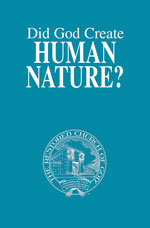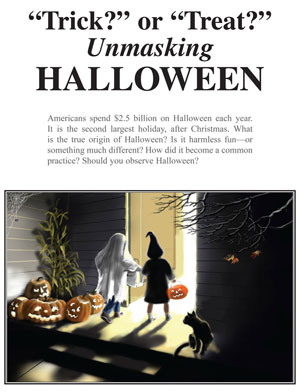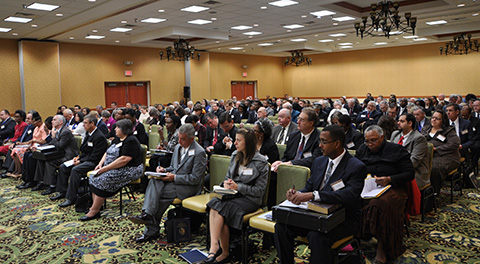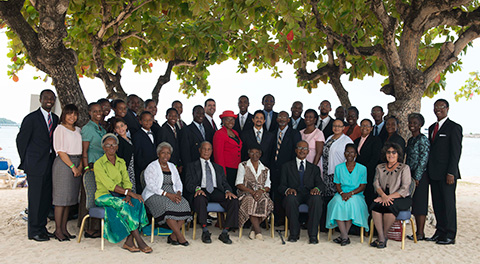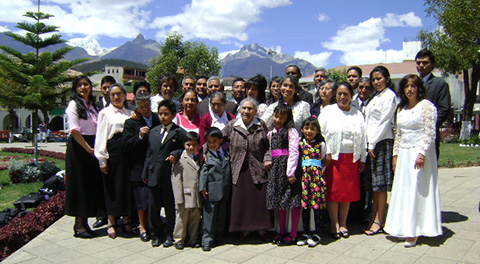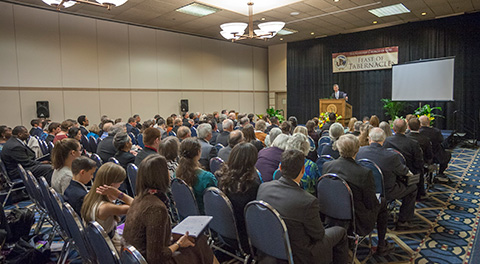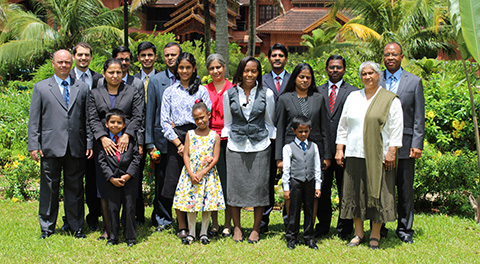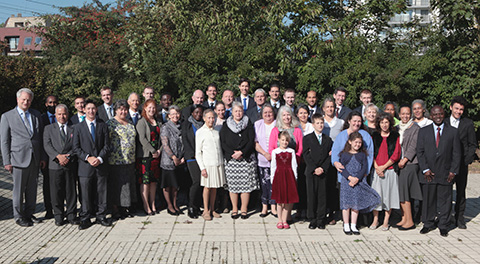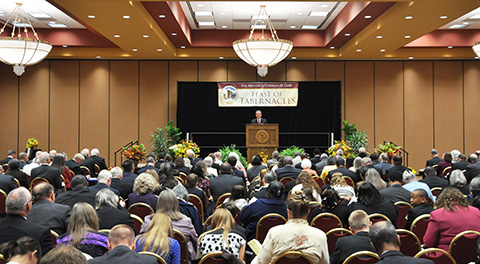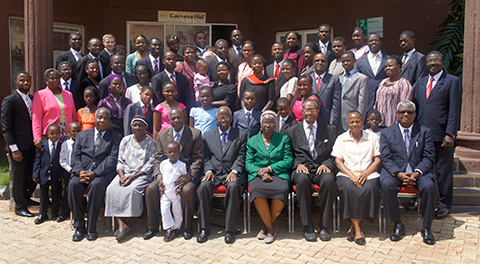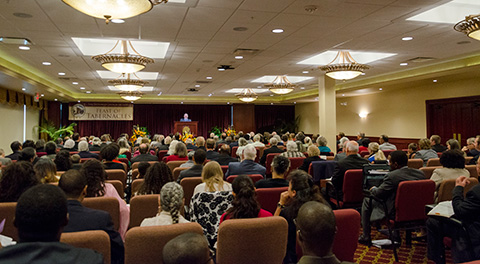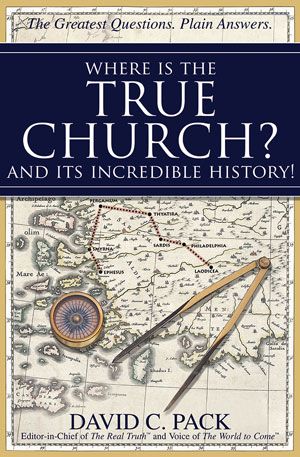Trick or treat! When said by children, these three words bring back a flood of childhood memories to most adults. Memories of masquerading as vampires, ghosts, witches, ghouls, monsters and fairies. Memories of canvassing the neighborhood, going door to door, shouting those three little words, and watching their bags fill up with all sorts of candies, apples, nuts and other goodies. Memories of parades, parties and playing “tricks,” like soaping the neighbors’ windows, “decorating” their trees with toilet tissue, or playing “baseball” with their roadside mailboxes.
Yes, hearing the words “trick or treat” from little children can cause adults to wish they were kids again.
“After all,” one might reason, “what’s so wrong with Halloween?” Most believe that it is just another harmless childhood indulgence—much the way they view Christmas and birthday parties. Many wonder, “What’s so wrong with having a little fun?”
Besides teaching children that it is alright to beg for something instead of earning it through work, and also turning them into extortionists (“trick or treat” essentially means “give me a treat or I’ll play a trick on you”), Halloween—its spooky costumes, scary jack-o-lanterns, juvenile tricks and colorful parades—may look like clean, innocent fun. But its traditions, customs and practices are rooted in a past far darker, far more sinister and far more demonic than you may realize.
Where did Halloween actually come from? How did it originate? How did it get to be so widely observed, especially in the United States? And what does God think about it? Does He view Halloween as clean innocent fun?
To find the answers, we must look into the history of Halloween. We will see that it is filled with pagan customs, masquerading as Christian traditions!
Halloween’s Pre-history
Let’s begin with the ancient Celts, who lived 2,000 years ago, in what is now Ireland, Great Britain and Northern France. The Celts were pagan nature worshippers who had many gods, including the sun, which they believed commanded their work and rest times. They believed the sun maintained the earth and kept it beautiful, and caused their crops to grow.
The Celts observed their new year on November 1, which marked the end of the harvest and summer (“the season of the sun”), as well as the beginning of the cold, dark winter ahead (“the season of darkness and cold”).
From October 31 to November 2, the Celts celebrated a 48-hour festival, the Vigil of Samhain (pronounced “sow-in”). They believed that Samhain, the pagan lord of the dead, assembled the souls of those who had died during the previous year and decided what form they would take for the next year. The souls would either pass on to human bodies or would be condemned to live within animals (the most evil of the bad souls or spirits would take the form of cats). Hoping to coax Samhain into giving lighter sentences, the Celtic worshippers tried to bribe him with gifts and prayers.
The Encyclopedia Britannica says the following: “Samhain (Celtic: ‘End of Summer’), one of the most important and sinister calendar festivals of the Celtic year. At Samhain, held on November 1, the world of the gods was believed to be made visible to mankind, and the gods played many tricks on their mortal worshippers; it was a time fraught with danger, charged with fear, and full of supernatural episodes. Sacrifices and propitiations of every kind were thought to be vital, for without them the Celts believed they could not prevail over the perils of the season or counteract the activities of the deities. Samhain was an important precursor to Halloween.”
On the night of October 31, the eve of the new year, the Celts, after harvesting their crops and storing them for the coming winter, began their festival. First, they extinguished the cooking fires in their homes. Then the Druids (Celtic priests) met on hilltops in the dark oak forests (they viewed oak trees as sacred), and built huge sacred bonfires to frighten away evil spirits and to honor the sun god. Next, the people would burn crop and animal sacrifices to their gods, dancing around the fires as the “season of the sun” passed and the “season of darkness” began. The Celts wore costumes of animal heads and skins, and told each other their fortunes. The next morning, they re-lit their cooking fires from the sacred bonfires, in order to free them from evil spirits—as well as to help protect them during the coming winter season.
“In ancient Britain and Ireland, the Celtic festival of Samhain eve was observed on October 31, at the end of summer. (It) was the occasion for one of the ancient fire festivals when huge bonfires were set on hilltops to frighten away evil spirits…The souls of the dead were thought to revisit their homes on this day, and the autumnal festival acquired sinister significance, with ghosts, witches, hobgoblins, black cats, fairies, and demons of all kinds said to be roaming about. In addition, Halloween was thought to be the most favorable time for divinations concerning marriage, luck, health, and death” (Encyclopedia Britannica).
Who Is the “Lord of the Dead”?
Now what about Samhain, the so-called lord of the dead? God tells us about “…him who had the power of death, that is, the devil” (Heb. 2:14). Satan the devil was lord, or master, of the dead! The ancient Celts, who thought they were serving God, were deceived into worshipping the god of this world, who is the father of lies and religious deception. We will see that this same being stands behind the modern-day festival of Samhain (Gal. 4:8; Rev. 12:9; II Cor. 4:4; John 8:44).
We have established that Satan once had the power over death—but he does not anymore. So who is the lord of the dead today? At this point, we need to briefly consider several scriptures.
Notice Matthew 22:31-32, where Jesus answers the Sadducees concerning the resurrection. “But concerning the resurrection of the dead, have you not read that which was spoken to you by God, saying, ‘I am the God of Abraham, and the God of Isaac, and the God of Jacob?’ God is not the God of the dead, but of the living.” Since the patriarchs are dead and God is only the God of the living—the dead do not serve God (Psa. 6:5, 115:17)—then there must be a resurrection from the dead so that they might live and serve Him.
But in order to make the resurrection possible, “Christ died and rose and lived again, that He might be Lord of both the dead and the living” (Rom. 14:9). Christ became the Lord and Master of the dead through His resurrection, and gained the keys of the grave and death (Rev. 1:18). Jesus Christ will resurrect the dead back to life so that they will serve Him and God the Father in the soon-coming world tomorrow.
As the Encyclopedia Britannica states, “[The festival of] Samhain was an important precursor to Halloween.” So far, Halloween’s origins do not seem so innocent.
And Then Came the Romans
During the first century, the Roman Empire invaded Ireland and the British Isles, conquering most of Celtic territory. The Romans ruled over them for hundreds of years, influencing Celtic and Anglo-Saxon customs and traditions. During this time period, two Roman festivals mixed in with the Celts’ festival of Samhain—Feralia and Pomona Day. Several American cities bear the pagan name Pomona, thereby unwittingly endorsing “Pomona Day.”
Feralia, which was held on February 21, was a Roman holiday designed to honor the dead, but essentially amounted to mass drunkenness and orgies, not unlike the other Roman holidays.
Pomona Day, celebrated on November 1, was a festival held in honor of Pomona, the Roman goddess of fruit, trees and fertility. Her sacred symbol was the apple.
Over the next three centuries, the customs of the festival of Samhain mixed with the practices of Feralia and Pomona Day. That is, until they were “white-washed” and “cleansed” by another religious power.
Next Came the Catholic Church
During the first, second and third centuries, all professing Christians—both true and false—suffered periodic persecution from the Roman Empire, which viewed any form of Christianity as an illegal religion. But in A.D. 313, that changed for some. The Roman Catholic Church—which began with the sorcerer Simon Magus, who is mentioned in chapter eight of the Book of Acts—found favor in the eyes of Emperor Constantine. (To learn more, read our book Where Is the True Church? – and Its Incredible History!) For the first time in the history of the Roman Empire, the pope, now backed by Roman civil authority, had free reign to determine what was “Christian”—and what was not.
Throughout the early years of the Catholic Church, worshippers observed special anniversaries for martyrs who had been executed for their beliefs. Soon there weren’t enough days in the calendar year to dedicate a specific day for each individual martyr, so the Catholics observed one feast day for all martyrs.
“In the fourth century, neighboring dioceses began to interchange feasts, to transfer relics, to divide them, and to join in a common feast; as is shown by the invitation of St. Basil of Caesarea (A.D. 397) to the bishops of the province of Pontus. Frequently groups of martyrs suffered on the same day, which naturally led to a joint commemoration…[T]he number of martyrs became so great that a separate day could not be assigned to each. But the Church, feeling that every martyr should be venerated, appointed a common day for all” (Catholic Encyclopedia).
So the Catholic Church, with the backing of the government, decided to “white-wash” a Roman holiday. Tired of admonishing the Romans for engaging in drunken revelries as an excuse to honor the dead (and desiring more converts), Pope Boniface IV, in A.D. 609, declared Feralia to be Christian. Instead of honoring all of the dead, they were now just to honor dead “saints.” Instead of drunken revelries, it would be a day of prayer and meditation. Instead of calling it Feralia, he changed it to All Saints’ Day. And he moved the date of its observance from February 21 to May 13. “Boniface IV, [on] 13 May, 609, or 610, consecrated the Pantheon in Rome to the Blessed Virgin and all the martyrs, ordering an anniversary” (Ibid.).
Then, Pope Gregory III, who reigned 731-741, “consecrated a chapel in the Basilica of St. Peter to all the saints and fixed the anniversary for 1 November” (Catholic Encyclopedia). He broadened “the festival [of All Saints’ Day] to include all saints as well as all martyrs” (Encyclopedia Britannica).
Meanwhile, the Celts were still observing the festival of Samhain in one form or another. The Catholic Church took note and Pope Gregory IV (827-844) attempted to replace it by moving All Saints’ Day from May 13 to November 1—the same day as Samhain—officially extending the festival to the entire church. All Saints’ Day became known as All Hallows Day, while October 31 became All Hallows Eve and, eventually, Halloween.
More Festival Changes
But the white-washing process was not finished. In A.D. 988, the Catholic Church instituted another day—All Souls’ Day—to commemorate “all the faithful departed, those baptized Christians who are believed to be in purgatory because they have died with guilt of lesser sins on their souls. It is celebrated on November 2. Roman Catholic doctrine holds that the prayers of the faithful on earth will help cleanse these souls in order to fit them for the vision of God in heaven…The date, which became practically universal before the end of the 13th century, was chosen to follow All Saints’ Day. Having celebrated the feast (All Saints’ Day) of all the members of the church who are believed to be in heaven, the church on earth turns, on the next day, to commemorate those souls believed to be suffering in purgatory” (Encyclopedia Britannica).
Now all of the souls of the dead had their own day of worship—saints, martyrs, and even lowly believers who were not worthy to be declared either saints or martyrs.
As with the festival of Samhain, the Catholic believers celebrated with huge bonfires, parades and costumes, masquerading as dead saints, angels and demons. Altogether, All Saints’ Eve (October 31), All Saints’ Day (November 1), and All Souls’ Day (November 2) combined into Hallowmas—mirroring the Celtic Vigil of Samhain! What was proclaimed Christian and clean and wholesome originated from drunken revelries, pagan superstitions and false doctrines dating back to the Garden of Eden.
The Hallowmas festival—and especially Halloween—was so popular that, in 1517, Martin Luther chose Halloween night to post his ninety-five theses on the door of the church in Wittenberg, Germany (which effectively started the Protestant Reformation). He picked this night because he understood that large crowds of people would be moving through the streets that evening!
Pagan Customs Come to America
As European immigrants began settling in the United States, while it was still in its infancy, they brought customs, traditions, superstitions and religious practices, including Halloween, from their homelands.
The biggest Halloween influence in America came with the millions of Irish settlers who immigrated to the U.S., after fleeing Ireland’s potato famine of 1846. Soon, Halloween, like Christmas, became a secular holiday for all. The day’s festivities included parades, parties, costumes, treats and mischief.
And so today’s Halloween customs (black cats, parades, dressing up as ghouls and witches, parties, bonfires, tricks and mischievous pranks)—which most people take for granted—point directly back to the Vigil of Samhain, the false lord of the dead, pagan Roman holidays filled with immoral revelries, and the Catholic Church’s Hallowmas.
In light of its historical pagan origin, can we honestly view Halloween as merely an innocent childhood indulgence? Is this the kind of tradition we want to pass on to our children?
Human nature will always argue, “Hold on, I don’t worship the sun or pray to some pagan ‘lord of the dead.’ I like Halloween because it’s fun. What’s wrong with that?”
What does God think? How does He view Halloween?
Engulfed in False Doctrines
Let’s review. We have established that Halloween originated with the Celts, who worshipped nature—the creation—rather than the one true God, who created nature and everything in it.
The apostle Paul wrote, “Because, although they knew God, they did not glorify Him as God, nor were thankful, but became futile in their thoughts, and their foolish hearts were darkened. Professing to be wise, they became fools, and changed the glory of the incorruptible God into an image made like corruptible man—and birds and four-footed beasts and creeping things. Therefore God also gave them up to uncleanness, in the lusts of their hearts, to dishonor their bodies among themselves, who exchanged the truth of God for the lie, and worshiped and served the [creation] rather than the Creator” (Rom. 1:21-25, NKJV throughout).
They had trusted the sun, as their god, to provide them with enough harvest crops to get them through the winter, rejecting God as their Provider. “‘…do not worry about your life, what you will eat or what you will drink; nor about your body, what you will put on. Is not life more than food and the body more than clothing?…do not worry, saying, “What shall we eat?” or…“What shall we wear?” For after all these things the Gentiles seek. For your heavenly Father knows that you need all these things. But seek first the kingdom of God and His righteousness, and all these things shall be added to you’” (Matt. 6:25-33).
They had put their trust in “sacred bonfires” to protect them from evil spirits, instead of trusting God as their Protector. “The Lord is my rock and my fortress and my deliverer; my God, my strength, in whom I will trust; My shield and the horn of my salvation, my stronghold. I will call upon the Lord, who is worthy to be praised; So shall I be saved from my enemies…For by You I can run against a troop, and by my God I can leap over a wall. As for God, His way is perfect; the word of the Lord is proven; He is a shield to all who trust in Him. For who is God, except the Lord? And who is a rock, except our God?…It is God who avenges me, and subdues the peoples under me; He delivers me from my enemies. You also lift me up above those who rise against me; You have delivered me from the violent man” (Psa. 18:2-3, 29-31, 47-48).
The Celts believed in the immortality of the soul, a false doctrine Satan had taught man in the Garden of Eden (Gen. 3:1-5)—and has used to deceive the whole world ever since that time (Rev. 12:9).
God says that when you die, you die. Period. No going to heaven (John 3:13; Acts 2:29, 34). No roaming the earth and haunting houses. No spending eternity in Purgatory, or some other humanly-devised place: “For the living know that they will die; but the dead know nothing, and they have no more reward” (Ecc. 9:5). “Behold, all souls are Mine…the soul who sins shall die” (Ezek. 18:4). Sin is the breaking of God’s Law (I John 3:4). “For the wages [what you earn] of sin is death” (Rom. 6:23), not eternal life, as most professing Christians falsely believe. Halloween sprang from direct opposition to God’s truth.
God’s Viewpoint
Notice what God says about pagan customs, traditions, practices and beliefs in general: “Learn not the way of the heathen, and be not dismayed at the signs of heaven; for the heathen are dismayed at them. For the customs of the people are vain” (Jer. 10:2-3, KJV).
God took a nation of slaves, Israel, and freed them from their cruel Egyptian masters. Leading them out of Egypt, He commanded them, saying, “According to the doings of the land of Egypt, where you dwelt, you shall not do; and according to the doings of the land of Canaan, where I am bringing you, you shall not do; nor shall you walk in their ordinances” (Lev. 18:3). God ordered the Israelites not to defile themselves with the practices and customs of the surrounding nations (vs. 24-29). “Therefore you shall keep My ordinance, so that you do not commit any of these abominable customs which were committed before you, and that you do not defile yourselves by them: I am the Lord your God” (vs. 30).
God gave Israel His laws, statutes and judgments. He gave them a way of life completely alien to mankind; a way that, if kept diligently and from the heart, will produce peace, joy, and prosperity—every good thing that He wants to abundantly share with all of humanity (John 10:10). God told the Israelites that they would be blessed beyond human imagination if they carefully kept His laws (Lev. 26:3-13). And that they would be greatly cursed if they rejected Him and replaced His ways with pagan customs, practices and traditions—no matter how innocent or harmless they seemed (vs. 14-39).
Yet, despite God’s warnings, Israel would not listen. Even after God had sent them servant after servant, throughout their turbulent history, they still would not repent and whole-heartedly turn to Him. “And the Lord God of their fathers sent warnings to them by His messengers, rising up early and sending them, because He had compassion on His people and on His dwelling place. But they mocked the messengers of God, despised His words, and scoffed at His prophets” (II Chron. 36:15-16). Because of their spiritual adultery and affinity for pagan practices, calling them holy when God calls them profane (Ezek. 22:26), God had no choice but to punish Israel. And, unfortunately, the modern-day descendants of Israel—the United States, Canada, Britain, Australia, Israel, and others—will very soon be severely punished for failing to discern what is holy from what is profane (Jer. 30:4-7; Ezek. 24:13-14).
The one true God—the Creator, Teacher, Lawgiver and Judge—does not take pagan practices lightly!
Satan Blinds the World
Most people do not believe that Satan the Devil exists—and that best suits his game plan. His goal is to keep the people of his world, his society, blind to his lies and deceits (II Cor. 4:4; Rev. 12:9). He even uses false ministers, who seem to be ministers of light, but are in reality Satan’s ministers of darkness.
Paul wrote, “And no wonder! For Satan himself transforms himself into an angel of light. Therefore it is no great thing if his ministers also transform themselves into ministers of righteousness” (II Cor. 11:14-15). Satan wants us to be so wrapped up in the customs and practices of this world—his world—that when presented with the plain truth about Halloween, we will shrug our shoulders and say, “I’m just celebrating it to have fun—what’s the big deal?”
Throughout mankind’s turbulent history, Satan has always managed to find a way to separate man from God (Isa. 59:1-3) by tempting him into various sins and false ideas that may seem right—that may seem innocent and harmless—but are in direct opposition to God! Jeremiah said, “O Lord, I know the way of man is not in himself; it is not in man who walks to direct his own steps” (10:23), and “The heart is deceitful above all things, and desperately wicked; who can know it?” (17:9). Even when the Roman Catholic Church attempted to gloss over strange pagan practices of the Celts and Romans, it introduced its own false, Satanic doctrines, passing them off as Christian. Halloween is riddled with deceit and falsehoods.
Yet, even after all the historical evidence and biblical insights are brought to light, there will still be those who continue to view Halloween as just another harmless childhood practice. Nothing will convince them otherwise. Like a gleaming, white-washed tomb (Matt. 23:27), Halloween may sparkle on the surface, but in God’s eyes, it is filled with every spiritually unclean and filthy thing imaginable, a foul stench to His nostrils (Isa. 65:5).
No man or religious organization has the power to “white-wash” Halloween and declare it to be Christian. God unmasks Halloween and sees it for exactly what it is!
Will you?
ORIGINS OF HALLOWEEN CUSTOMS
Below is a list of widely-held customs and their ancient roots:
Mischief-making, playing tricks: Celts believed that the ghosts of the dead who returned to earth on the night of Oct. 31 caused trouble and damaged crops; they also believed that their gods played tricks on them.
Black cats: Celts believed that bad spirits would take the form of cats and other animals on the night of Oct. 31.
Costumes: Celts (and other Europeans) wore masks when they left their homes after dark to avoid being recognized by ghosts who might mistake them for fellow spirits. “Guisers” dressed up to impersonate the returning dead, singing and dancing to keep evil spirits away. Catholics dressed up as saints, angels and devils during Hallowmas.
“Trick or treat”: Prior to the Protestant Reformation, women and girls went “souling,” visiting houses and begging for “soul cakes.” Seventeenth-century Irish peasants went door to door asking for donations for a feast to honor St. Columba (whom they believed had replaced the Lord of the Dead). Up until the early 1900s, the Irish went about asking for contributions in the name of “Muck Olla,” a legendary, gigantic boar.
Bonfires: Druids built sacred bonfires to frighten off evil spirits on Oct. 31, eve of the new year. Worshippers used them to burn animal and crop offerings to their sun god; they also rekindled their cooking fires to protect their homes from evil spirits. The Scots built bonfires, called Samhnagan, not for Samhain, but for Halloween merry-making and as a defiant welcome to the coming winter. The Catholic Church continued with the bonfire tradition on All Souls’ Day, Nov. 2.
Fruits, nuts and other goodies: Handing out fruits and nuts may have originated from Pomona Day, named for the Roman goddess of fruits, trees, gardens, harvests and fertility. Later used for divination games.
Apple-bobbing, apple-ducking: May have come from Pomona Day; the Romans viewed the apple as a sacred symbol of their goddess Pomona. Apple-ducking was a divination game used to predict future love and marriage; for example, if a girl peeled an apple in front of a mirror in a room lighted by a candle, an apparition of her future husband would appear behind her in a mirror. Also, apple-ducking represented soul symbols (apples) in the Cauldron of Regeneration (the water), similar to the lord of the dead gathering dead souls to regenerate those who had been condemned to inhabit animals for the past year.
Parades, parties: The Scots, Celts and Welsh built bonfires for parading, dancing and merry-making; the Celts did so, wearing costumes made from animal skins and heads. The Scots assembled marriage-minded young people for divination games. Europeans who migrated to America brought with them “play parties” and public events to celebrate the harvest, as well as telling ghost stories and pulling pranks.
Jack-o’-lantern: The name may have come from a night watchman. In the British Isles, turnips and rutabagas were commonly used; pumpkins are the American tradition. In Britain, people hollowed out turnips and placed candles inside them to make food offerings to the dead; later on, they were posted just outside homes to keep away evil spirits.
Sources: Encyclopedia Britannica; “History Channel Exhibits: The History of Halloween”

